|
NATURE NOTES 2000 |
NATURE NOTES 2001 |
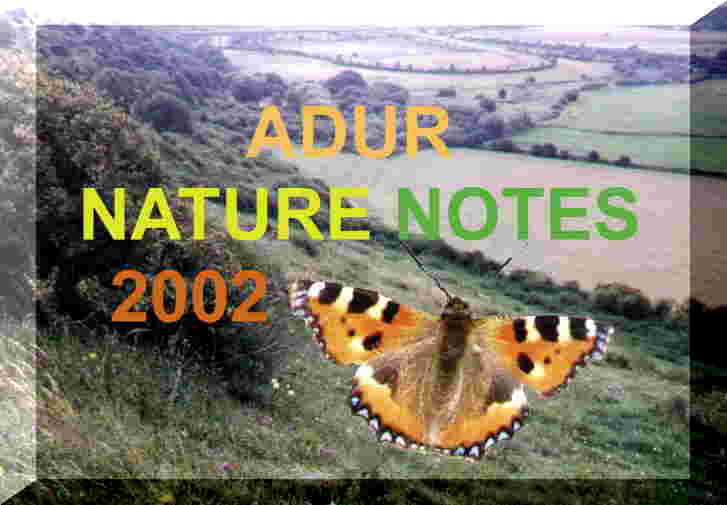 |
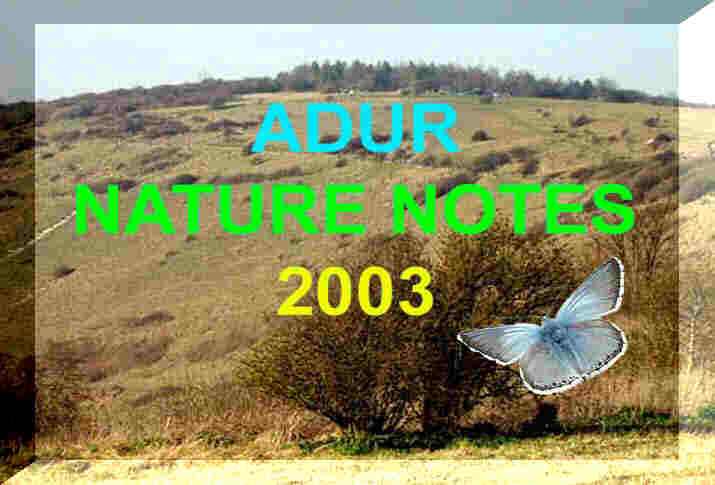 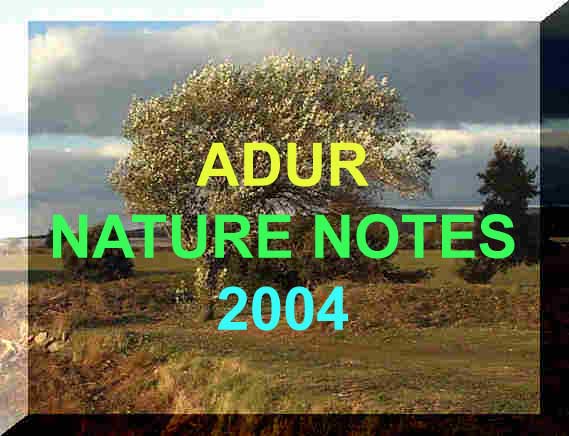 |
Cissbury Ring
Beeding
Hill to Newtimber Hill (includes Devil's Dyke)
Adur
Estuary
Sites of Nature Conservation Importance (Link to)
|
NATURE NOTES 2000 |
NATURE NOTES 2001 |
 |
  |
Flora:
Bird's
Foot Trefoil, Horseshoe Vetch, Harebell,
Field Bindweed, Small
Scabious, Violets,
Greater
Knapweed,
Stemless
Thistle, Eyebright,
Round-headed
Rampion, Cowslip, Pyramid
Orchid.
ORCHID SLIDE SHOW (CD-ROM only, photographs by Ray Hamblett)
Fungi: Field Mushroom, Puff-Ball (in August 1999, Shirley Carden of Southwick found a Puff-Ball weighing 4.4 kg [9 lb 12 oz] )
Scrub Flora: Dogwood, Hawthorn, Wayfaring Tree.
Trees: Elm, Ash, Beech (Lancing Clump), Sycamore (western slopes of Mill Hill).
Flora in cultivated areas: Poppy.
Hedgerows (always absent from many areas): Ash trees are planted
amongst the hedges.
Birds: Skylark, Magpie, Crow, Kestrel.
Autumn Birds: Fieldfare, Redwing.
Plant Species: Starry
Clover, Yellow-horned
Poppy, Tamarisk, Sea Kale,
Italian Catchfly, Viper's
Bugloss,
Bittersweet,
Sea Beet, Silver Ragwort, Sea Plantain, Dock, Tree Mallow, Sea
Campion, Rock Samphire, Thrift,
Yellow Stonecrop, Field Bindweed,
Opium Poppy, Mayweed, Cow Parsely, Bird's
Foot Trefoil, Red Valerian,
Childing
Pink.
Birds: Ringed Plover, Goldfinch, Greenfinch, Wheatear, Chaffinch, Cormorant, Pied Wagtail, Crow, Black-headed Gull.
Reptiles: Common (or Viviparous)
Lizard, Zootoca vivipara.
Seashore
Link to FLOWERING PLANTS
OF THE SHINGLE
Adur
Nature Notes 2003
Bungalow
Town
Dungeness,
Kent, England
Lancing
Ring (Ray Hamblett)
Orford
Ness: Coastal Ecology of a Shingle Bank (excellent references)
Rye
Harbour Nature Reserve
Common Birds: Black-headed Gulls, Cormorants, Dunlin, Mute Swans, Redshank, Greater Black-backed Gulls.
Inverts: Bilge Bugs, Shore Crab, Mussels,Cockles, Periwinkles.

Salt Marsh: Glasswort (Marsh
Samphire), Sea Purslane,
Sea Aster, Sea Spurrey, Sea Arrow Glass, Sea Lavender ?, Sea Blite
Estuary File
Flora: Sea Purslane (abundant), Glasswort.
Algae: Carrageen.
THE ADUR
ESTUARY
A
SURVEY OF THE MARINE FLORA AND FAUNA
1960 TO
1992
Flora: Blackthorn, Willow (both important for insect fauna),
Primrose, Bramble, Elder, Thistles, Creeping Cinquefoil, Duckweed, Violets,
Orache, Elm, Teasel, Cow Parsley, Dog Rose, Dock, Mallow, Yarrow, Dogwood,
Lower Slopes of the Downs: Sycamore, Field Maple, Ash, Hawthorn, Beech.
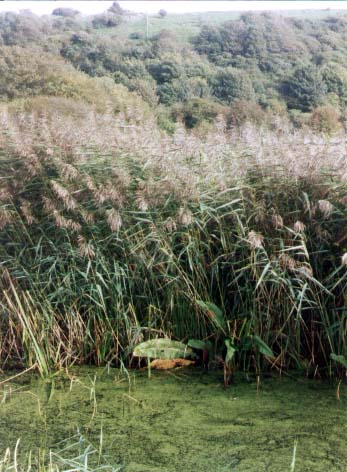 Town
fringes: Stinging Nettle, Dock.
Town
fringes: Stinging Nettle, Dock.
Reptiles & Amphibians: Common Frog, Common Toad, Grass Snake, Common Lizard (also called Viviparous Lizard).
Interesting Insects: Common Blue Butterfly, Buff-tailed Bumblebee, Meadow Brown Butterfly, Small Tortoiseshell.
Mammals: Mink, Stoat, Fox, Rabbits, Roe Deer.
Birds: Starling, Grey Heron, Lapwing, Cuckoo, Wren, Robin, Blackbird.
Fish: Flounders, Eels, Bass, 3-spined Stickleback.
Link to the British Dragonfly
Society
Fish: Black 'Skimmer' Bream, Sole, Bass,
Dab, Dragonet, Cod, Lumpsucker,
Corkwing
Wrasse,
Grey Mullet, Dogfish,
Mackerel,
Garfish, Greater Pipefish, Monkfish, Thornback Ray, Conger, Montagu's
Sea Snail, Basking Shark.
Photograph:
Actinia fragacea
"Strawberry"
Beadlet Anemone
Inverts: Spiny Spider Crab, Edible Crab, Oysters, Mussels, Common Starfish, Buntings (Prawns), Brown Shrimp, Plumose Anemone, Moon Jellyfish, various Sea Squirts.
Fish Slide Show
Jellyfish Page
Oyster & the Slipper
Limpet
Sussex Dolphins (article)
Unusual Sussex Fish Discoveries
August 1998: Large Bass continue to be taken from the shore
and piers at Shoreham-by-Sea, Sussex.
The latest weighed 6.35 kg (14 lb).
Species: Hedgehog (common), Fox, Weasel, Rabbit.
Birds:
Pied Wagtail (Dishwasher)*, Jackdaw, Oystercatcher, Black-headed Gull,
Kestrel, Mistle Thrush, Magpie, Collared Dove, Blackbird, Wren, House Sparrow,
Crow, Starling.
The Feral Pigeon is only occasionally seen but is found on Shoreham-by-Sea railway station, about the only place in the town where it can be regularly seen.
Flora (worth looking at): Bittersweet, Field Bindweed, Rosebay Willowherb, Common Mallow, Mayflower, Bramble (Blackberry), Tufted Vetch, Elder.
Trees:
Sycamore, Yew, Sweet Chestnut, Holly, Poplar, Oak, Holm Oak, Linden (Lime),
Scots Pine.
Hamme Field Allotments:
Song Thrush.
Church Lane, Southwick:
Birds Breeding: Sparrowhawk, Song
Thrush.
Birds visiting: Green Woodpecker (feeds
on the ground), Jay, Greenfinch, Goldfinch.
[* see the note in the Oxford Companion to Animal Behaviour, page 182.]
Seaweeds washed up on the beach at Shoreham
Birds: Dunlin, Ringed Plover, Oystercatcher, Black-headed Gull, Cormorant, Avocet (rare), Little Auk (rare), unidentified diving ducks, Brent Goose.
Species: 3-spined Stickleback
(infected with the parasite Cryptocotyle),
Lagoon Cockle.
Life
style of the trigenetic parasite Cryptocotyle lingua.
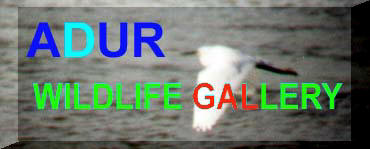 Little
Egret (now regular, 1999), Spoonbill, Osprey, Redshank (leucistic specimen),
Water Pipit, Grey Phalarope, Little Auk, American Laughing Gull (one record
only), Mediterranean Gull, Smew (January 1996), Glaucous Gull, Puffin (oiled
birds), Treecreeper (common bird that is uncommon locally), Ring-necked
Parakeet (escapes or naturalised?), Red-breasted
Merganser (in bad weather in winter), Purple Heron (one record).
Little
Egret (now regular, 1999), Spoonbill, Osprey, Redshank (leucistic specimen),
Water Pipit, Grey Phalarope, Little Auk, American Laughing Gull (one record
only), Mediterranean Gull, Smew (January 1996), Glaucous Gull, Puffin (oiled
birds), Treecreeper (common bird that is uncommon locally), Ring-necked
Parakeet (escapes or naturalised?), Red-breasted
Merganser (in bad weather in winter), Purple Heron (one record).
New Adur District Wildlife
site
Sussex
Ornithological Society
WILDLIFE ![]() BOOK
HUNT
BOOK
HUNT

| Adur Valley |